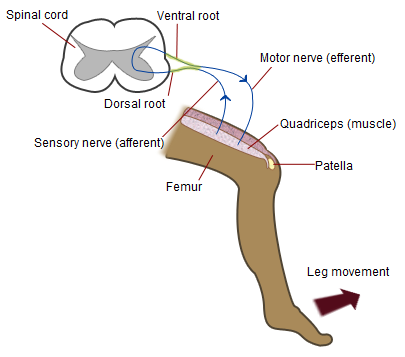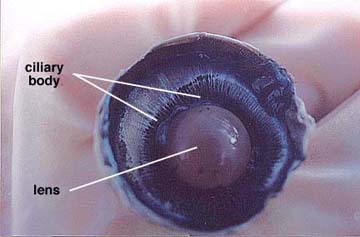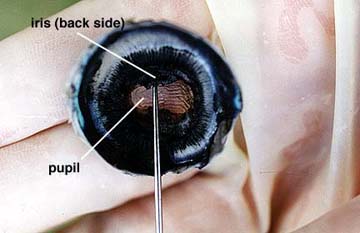Today in class we tested out our reflexes. Reflexes are rapid, predictable, and involuntary responses to stimuli. A reflex arc us a pathway to nerve impulses, they do not go to the brain.
1. The Photopupillary Reflex
The smooth muscles of the iris function to control the size of the pupil. For example, the intensity of light entering the eye increases, the photopupillary relfex is triggered, and the cilliary body of the iris is stimulated to contract. As a result, the size of the pupil decreases, and the less light enters the eye.
For me, the reflex happened after I closed my eye for two minutes and then exposed it to bright light, which made my pupil decrease in size.

2. Knee Jerk Reflex
This reflex is called a monosynaptic reflex because there is only one synapse in the circuit needed to complete the reflex. A tap below the knee causes the thigh muscles to stretch. Information is then sent to the spinal cord. After one synapse in the ventral horn of the spinal cord, the information is sent back out the muscle and there you have the reflex.
For me, the reflex worked, even when I was trying to prevent it. My knee jerked forward. After doing 50 squats, I was very fatigued and the patellar reflex didn't work because I used all my ATP at my knee and the tap caused no muscle contraction.

3. Blink Reflex
The Blink reflex is designed to protect our eyes. Eyes are very fragile and cannot be replaces so it is very important to protect them, which this reflex does. If eyelids get hurt, they can repair themselves but our eyes cannot.
I blinked even with a thin transparent barrier when a cotton ball was thrown at me.
4. Babe, what is your sign?
In adults, a typical response to the plantar reflex, which is when one person strokes another person's sole of their feet from heel to base of the big toe, is that the toes will flex and move closer together. This happened for me. However if there is nerve damage one might show Babinski's sign, where the toes spread apart and upward. In newborn, Babinski's sign should always be seen since their nervous system is not completely myelinated yet.


5. For the last reflex test, we are asked to catch a ruler dropped at unknown time, to determine the rate at which our relfexes work. For me I was able to catch the ruler at an average time of 0.28 seconds without texting and with texting at an average time of 0.18 seconds.
My reaction time was faster when texting because I already got practice catching the ruler and was more alert when catching the ruler. Although this shouldn't be the case because we perform tasks less efficiently when multitasking because our brains cannot multitask. It can only switch between tasks really quickly.

Here is our class's data:

1. The Photopupillary Reflex
The smooth muscles of the iris function to control the size of the pupil. For example, the intensity of light entering the eye increases, the photopupillary relfex is triggered, and the cilliary body of the iris is stimulated to contract. As a result, the size of the pupil decreases, and the less light enters the eye.
For me, the reflex happened after I closed my eye for two minutes and then exposed it to bright light, which made my pupil decrease in size.

2. Knee Jerk Reflex
This reflex is called a monosynaptic reflex because there is only one synapse in the circuit needed to complete the reflex. A tap below the knee causes the thigh muscles to stretch. Information is then sent to the spinal cord. After one synapse in the ventral horn of the spinal cord, the information is sent back out the muscle and there you have the reflex.
For me, the reflex worked, even when I was trying to prevent it. My knee jerked forward. After doing 50 squats, I was very fatigued and the patellar reflex didn't work because I used all my ATP at my knee and the tap caused no muscle contraction.

3. Blink Reflex
The Blink reflex is designed to protect our eyes. Eyes are very fragile and cannot be replaces so it is very important to protect them, which this reflex does. If eyelids get hurt, they can repair themselves but our eyes cannot.
I blinked even with a thin transparent barrier when a cotton ball was thrown at me.
4. Babe, what is your sign?
In adults, a typical response to the plantar reflex, which is when one person strokes another person's sole of their feet from heel to base of the big toe, is that the toes will flex and move closer together. This happened for me. However if there is nerve damage one might show Babinski's sign, where the toes spread apart and upward. In newborn, Babinski's sign should always be seen since their nervous system is not completely myelinated yet.


5. For the last reflex test, we are asked to catch a ruler dropped at unknown time, to determine the rate at which our relfexes work. For me I was able to catch the ruler at an average time of 0.28 seconds without texting and with texting at an average time of 0.18 seconds.
My reaction time was faster when texting because I already got practice catching the ruler and was more alert when catching the ruler. Although this shouldn't be the case because we perform tasks less efficiently when multitasking because our brains cannot multitask. It can only switch between tasks really quickly.
Here is our class's data:




 Thalamus (yellow), Midbrain (blue), Medulla Oblongata(Red), Pons (Green)
Thalamus (yellow), Midbrain (blue), Medulla Oblongata(Red), Pons (Green)



 White and Gray Matter
White and Gray Matter











